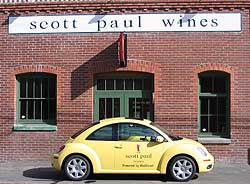 I find George Will particularly irritating. The conservative columnist and television commentator is just too smart and well-spoken. All too often in face-to-face debates he shreds the argument of the liberal commentator across the table from him with his swifter wit and broader knowledge. It ticks me off no end.
I find George Will particularly irritating. The conservative columnist and television commentator is just too smart and well-spoken. All too often in face-to-face debates he shreds the argument of the liberal commentator across the table from him with his swifter wit and broader knowledge. It ticks me off no end.
In the debate about so called “natural” winemaking we have the same situation. Clark Smith, winemaker, super-consultant and king of spoofulated wines as the owner of Vinovation, is becoming as irritating to me as Will and for the same reasons. Smith, who makes his own wines besides consulting and “correcting” wines for hundreds of wineries, just has too much knowledge and experience for it to be a fair fight when it comes to debating winemaking ethics with people who have never made wines themselves. All to often these people are known as wine writers. It does surprise me how many writers who have don’t have enology degrees and whose experience working harvests is more akin to adventure vacations than real winemaking come to consider themselves winemaking experts. After all, does a trip to a dude ranch make you a cowboy?
Smith uses his superior knowledge and experience to effectively dismantle the “natural” winemaking debating team’s positions (which I mostly agree with) as he did in a recent article published on Appellation America’s website called Spoofulated or Artisanal, which is well worth reading. Spoofulated, for those unfamiliar with the term that debuted on the Wine Therapy Forum and became part of wine lingo, refers to manipulated wines, which are often made in a style that appeals to Robert Parker and The Wine Spectator. It is a word used as an insult by those seeking a more terroir-driven winemaking experience as spoofulated wines all-to-often taste more-or-less the same.
Is spoofulation always evil? I don’t think so. Commercial wines, which are produced for consumers not seeking nuance or complexity, but just a “winey” tasting beverage are better wines than ever due to these techniques. For all to long these inexpensive wines produced in huge quantities were thin and faulted. However, now those seeking nothing more can easily buy clean, fruity wines that neither require nor invite thought or contemplation. It is a fact of the market that the vast majority of consumers are perfectly satisfied with such wines and want nothing more. Clark Smith and his methods are a positive boon to such consumers.
It’s when wines pretend to more lofty goals that Clark Smith and I part company. I’ll draw an arbitrary line at the $10 a bottle point. That’s starting to get expensive and I think the consumer has a right to expect that wines with different labels will actually be different wines. The main problem with spoofulated wines is that they all taste the same. The differences get manipulated out as the wine is more-and-more manipulated. The fact that there are so many expensive New World wines that exhibit the bright simple ripe flavors of the commercial wines mentioned above is a real problem that is starting to destroy the reputation of places like the Napa Valley. Consumers that are willing to spend a significant amount of money for these wines are starting to realize how boring they are.
On the other end of the argument are writers who are “natural” wine fundamentalists who seem to believe the high point in winemaking knowledge was achieved by the Romans and any technique or knowledge achieved after Nero are unnatural manipulations that destroy a wines terroir. Of course such extremists only display their limited winemaking knowledge and a lack of sophistication as they (instead of the wines) are manipulated by winemakers who tell them only what they want to hear. While there are many winemakers who believe in and practice minimalist, natural winemaking, there are few to none willing to let several tons of fruit in a fermenter with problems become garbage without taking actions that don’t always meet these ideals. These are stories that journalists are unlikely to hear or understand if they did. Contrary to some writers opinions, winemakers sometimes actually have to make wine.
Spoofulators like Clark Smith and biodynamic guru Nicolas Joly actually have more in common than partisans on either side of the debate understand. Both are passionate, brilliant winemakers who are driven to pursue their vision of what makes a wine great. To make a truly great wine you need to ignore the ranting of journalists and the whims of consumers and make the wine you believe in. This is something that winemakers like Smith and Joly share.
As always, those that oversimplify issues are usually blinded to the finer points of the debate.







